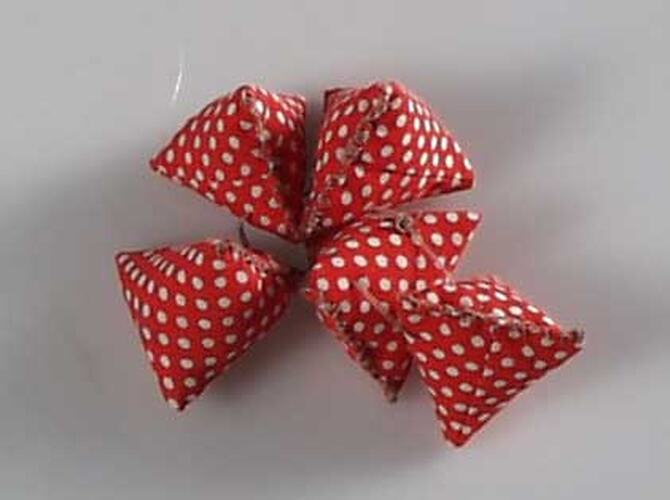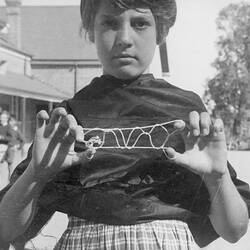Summary
Alternative Name(s): Singapore Jacks, Cloth Jacks
Five pyramid-shaped cloth jacks from Singapore, made from red and white fabric and filled with seeds or rice. They resemble the Japanese otedama form of jacks.
Playing Jacks with small fabric playing pieces is a traditional game for girls in Singapore. The jacks are usually small bags, traditionally pyramid-shaped, which are filled with sand or rice to give them weight. Sand has been the usual filling, as rice is a staple food, and it is sometimes thought to be disrespectful to use it as a plaything. The game is similar to Knucklebones. These jacks are typical examples of the playing pieces made and used by children in Singapore.
Jacks is an ancient game, dating back to prehistoric times. The first jacks were natural materials - animal bones, stones, seeds and shells, and when the game became a popular part of children's culture, manufacturers began mass-producing them from plastic and metal. In Australia, jacks are mostly shaped like sheep's knucklebones, but overseas there are also ceramic cubes and 'star'-shaped metal pieces. These stones are an example of the natural materials used by children to play jacks in the United States in the early 20th century.
Part of the Australian Children's Folklore Collection. The ACFC is unique in Australia, documenting contemporary children's folklore across Australia and in other countries, reaching back to the 1870s, and with a strong component of Victorian material.
Physical Description
Five little pyramid-shaped jacks, made from fabric and very tightly filled with seeds or rice. The fabric is red with white spots, and each jack is hand-stitched with brown thread along one seam. The jacks are attached to each other by a brown doubled thread.
More Information
-
Collection Names
-
Collecting Areas
Leisure, Home & Community, Childhood, Migration & Cultural Diversity
-
Acquisition Information
Cultural Gifts Donation from Dr June Factor, 18 May 1999
-
Acknowledgement
Donated through the Australian Government's Cultural Gifts Program.
-
Place Made
-
Classification
-
Category
-
Discipline
-
Type of item
-
overall dimensions
7 cm (Length), 7 cm (Width), 3.5 cm (Height)
-
Exhibition Collection Management
53 mm (Length), 66 mm (Width), 24 mm (Height)
dimensions are for each jack; group of 5
-
Keywords
Children's Folklore, Children's Play, Cultural Traditions, Games, Handmade Games & Toys, Making History - Australian Childrens Folklore


